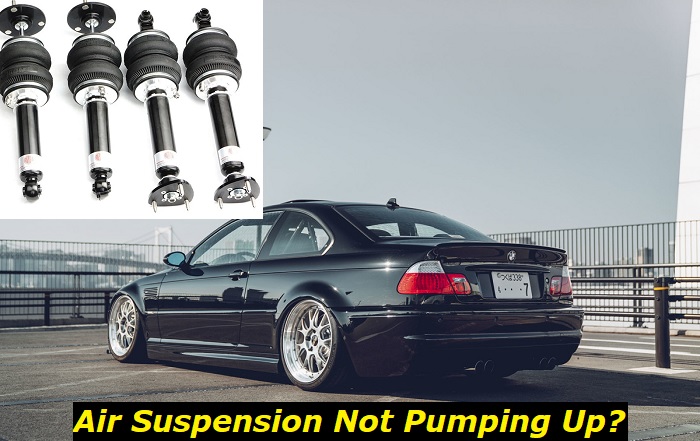Air suspension technology has been in existence since the 1900s, and its application in automobiles is no longer new. In 1957, the system was integrated into the Cadillac Eldorado, which paved way for its availability to a wide range of regular consumers. From then on, it has evolved into different types, which offer varying kinds of benefits to users.
Air suspension problems highlights
- Level of importance:medium
- Common reasons:internal suspension failure, electronic problem
- DIY inspection:impossible
- DIY repair:impossible
- Average price in shops:$550 - $1,900
- Average time:5 - 20 hours
- If ignored:fatal failure, car drops, hard driving

What It Does
Before anything else, it's good to understand the fundamental elements of air suspensions so you will have an idea of their basic function. Basically, an air suspension is a type of vehicle suspension that uses air springs instead of conventional metal springs. These air springs are inflated with air to provide pressure that's capable of supporting the weight of the vehicle and can be adjusted to provide a softer or firmer ride.
The benefits of air suspension vary. In terms of performance, air suspension can improve handling and braking by keeping the tires in constant contact with the road surface. It can also improve fuel economy by reducing aerodynamic drag. Safety is also improved as air suspension can help to keep the vehicle stable in emergency maneuvers or adverse weather conditions. Comfort is another major advantage because air suspension can smooth out bumps in the road and reduce vibration.
There are, however, some potential drawbacks to air suspension. One is that it can be expensive to repair or replace if it fails. Another is that it can be less reliable than conventional springs, as the air compressor and other components are susceptible to failure. Finally, air suspension can add weight to the vehicle, which can impact fuel economy and performance.
If your suspension fails, there are a number of potential consequences. The most minor may be a rougher ride, as the air springs will no longer be able to cushion the bumps in the road. More serious problems can include loss of control of the vehicle, particularly at high speeds, and tire failure due to the loss of support from the suspension. In extreme cases, the complete collapse of the suspension system can occur, leading to a serious accident.
While air suspension has many advantages, it is important to be aware of the potential risks involved. If you suspect that your suspension system may be failing, it is important to have it checked by a qualified mechanic as soon as possible.
Common Issues
As mentioned earlier, the air suspension system found in cars nowadays has become so advanced. Thus, it follows that the problems related to it have become more complex as well.
The factors preventing the air suspension from airing up can vary between mechanical and electrical issues. The most common causes of the problem are the following:
1. Electrical Problems
If your air suspension isn't airing up, it's likely due to an electrical problem. The possible causes include a faulty fuse, wiring, switch, or other electrical components interfering with the operation of the said parts.
Solutions to this problem may involve cleaning the corroded or dirty parts to ensure the proper contact of the connectors of the electrical parts as well as to allow the effective flow of current in them. In some cases, irreparable damages may require the replacement of the damaged parts. The entire air suspension system may have to be rebuilt or replaced, too, if the issue has compromised
Electrical issues can be challenging to identify and fix. If you're having trouble troubleshooting the problem, consult a qualified mechanic or your car dealership for assistance.
2. Clogs and Leaks
Another common cause of air suspension problems is a clogged air line, which can prevent the air from flowing freely into the system. This can be caused by dirt or debris in the line, or by a buildup of moisture. In some cases, it may be necessary to replace the air line entirely.
Another possible cause of this problem is a leak in the air suspension system. This can be caused by a number of factors, including poor seals, cracked air tank, and other damaged parts either due to wear and tear over time or poor driving habits. If you suspect that there is a leak in your system, it is important to have it checked out by a qualified mechanic as soon as possible who will have to replace the worn components. If left unchecked, a leak can cause further damage to the system and may eventually lead to a complete failure of the air suspension.
In some cases, it may be necessary to replace the entire air suspension system. This is usually only necessary if the system has been damaged beyond repair or if it is not possible to fix a particular problem. Replacing the entire system can be a costly endeavor, so it is important to weigh all of your options before making a decision.
Ignoring the problem can lead to further damage to the system and may eventually result in a complete failure of the air suspension. By taking care of the problem now, you can avoid a costly repair bill later on.
3. Malfunctioning Compressor
The compressor is responsible for pumping compressed air into the air suspension system to keep the air springs inflated. When the compressor malfunctions, it can hinder the air suspension from airing up, resulting in a number of problems.
The compressor must be changed if it is damaged. Do note that this is a more complicated affair that should be handled only by a professional mechanic. Parts that may need to be replaced as a result of damage to the compressor include the air springs, air lines, and air dryer. In some cases, the entire air suspension system may need to be replaced.
When troubleshooting a compressor that is not working properly, it is important to rule out all other possible causes like the electrical issues mentioned earlier before concluding that the compressor is defective. Replacing a compressor is a major repair and should only be done as a last resort.
4. Fault in Solenoid Valve Manifold
A solenoid valve manifold is a key component of an air suspension system. It is responsible for controlling the flow of air to the air springs or bags. If the manifold malfunctions, it can result in problems with the suspension system.
The possible problems that can occur if the solenoid valve manifold malfunctions include the air springs not inflating properly, getting uneven ride height, and bounciness when driving over bumps. These problems can be due to a variety of factors, including a leak in the air lines, a faulty pressure sensor, or a problem with the electrical connection to the manifold.
To start your diagnosis, make sure that there are no leaks in the air lines, the pressure sensor is working well, and all the electrical connections are in place. If the problems with the solenoid valve manifold cannot be fixed, then it may be necessary to replace the entire air suspension system. This is a more complicated repair that should only be done by a qualified mechanic.
5. Damaged Ride Height Sensor
The ride height sensor is a crucial component of the air suspension system. Its function is to monitor the height of the vehicle and send signals to the air suspension control module. This information is used to adjust the air pressure in the suspension system accordingly.
If the ride height sensor malfunctions, it can cause the air suspension not to inflate properly. This can be due to some issues such as a faulty sensor, a wiring issue, or a problem with the air suspension control module.
There are several possible solutions to this problem. The first and simplest is to check the ride height sensor itself and make sure that it is clean and free of debris. If it appears to be damaged, it may need to be replaced.
Another option is to examine the ride height sensor's wiring. It will be necessary to fix or replace any loose or broken wires.
In some circumstances, if the air suspension control module is malfunctioning, it may need to be replaced. Only a trained technician should attempt to do this more difficult repair.
On the other hand, if the ride height sensor is damaged beyond repair, it will need to be replaced. This can be a costly repair, so it is important to make sure that all other possible causes have been ruled out before proceeding with this option.
Conclusion
Car suspensions are made up of several components. While the repair may take many hours to complete, you should set aside a budget between $1,000 and $5,000 for the task. The specific cost depends on the extent of the damage and the kind of replacement parts your car requires.
On the other hand, the immediate repair or replacement of whatever part is causing your suspension to fail can prove to be the smartest decision you will ever make. Doing so could mean ensuring the integrity of your car to lengthen its lifespan and guaranteeing the safety of its occupants.
About the authors
The CarAraC research team is composed of seasoned auto mechanics and automotive industry professionals, including individuals with advanced degrees and certifications in their field. Our team members boast prestigious credentials, reflecting their extensive knowledge and skills. These qualifications include: IMI: Institute of the Motor Industry, ASE-Certified Master Automobile Technicians; Coventry University, Graduate of MA in Automotive Journalism; Politecnico di Torino, Italy, MS Automotive Engineering; Ss. Cyril and Methodius University in Skopje, Mechanical University in Skopje; TOC Automotive College; DHA Suffa University, Department of Mechanical Engineering






Add comment